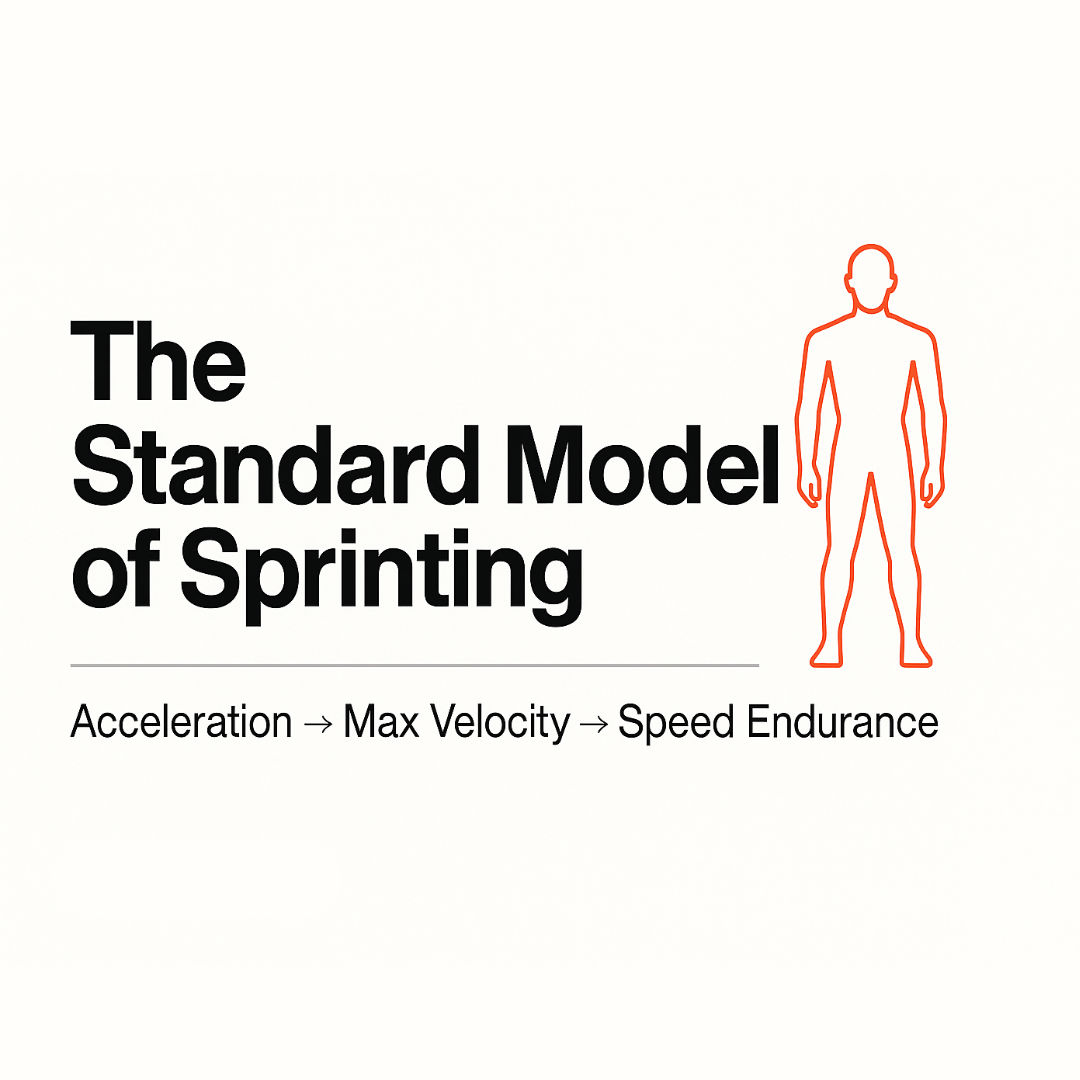
The Standard Model of Sprinting: Why Modern Biomechanics Has Changed the Game
Discover how modern biomechanics is reshaping sprint training, replacing outdated “base building” with max velocity and acceleration-first methods.

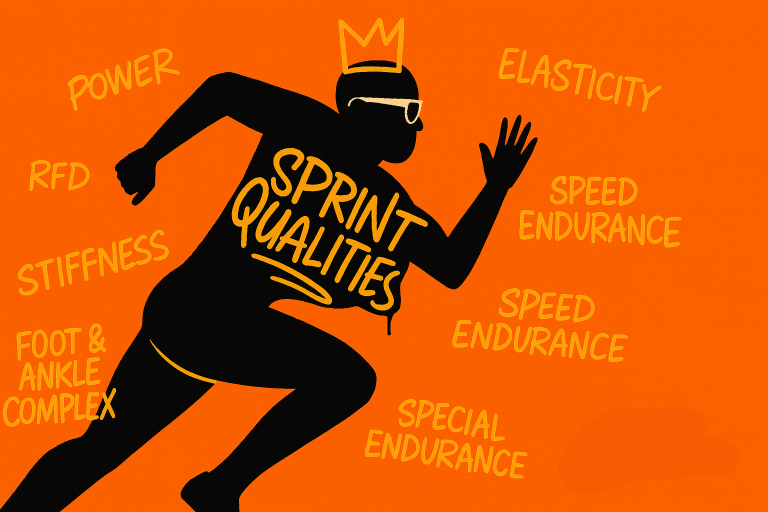
What Are Sprint Qualities? A Simple Definition…
Sprint qualities are the specific physical and technical attributes that determine a sprinter’s ability to accelerate rapidly, achieve maximum velocity, and maintain speed efficiently. These trainable characteristics include power (force production in minimal time), rate of force development (RFD), stiffness (muscle-tendon resistance to deformation during ground contact), foot and ankle complex strength, elasticity (ability to store and release energy), proper posture and pelvic control, coordination and rhythm, and speed endurance. Elite sprinters develop these qualities through targeted training methods to optimize performance across all phases of sprinting.
BOUNCE Formula
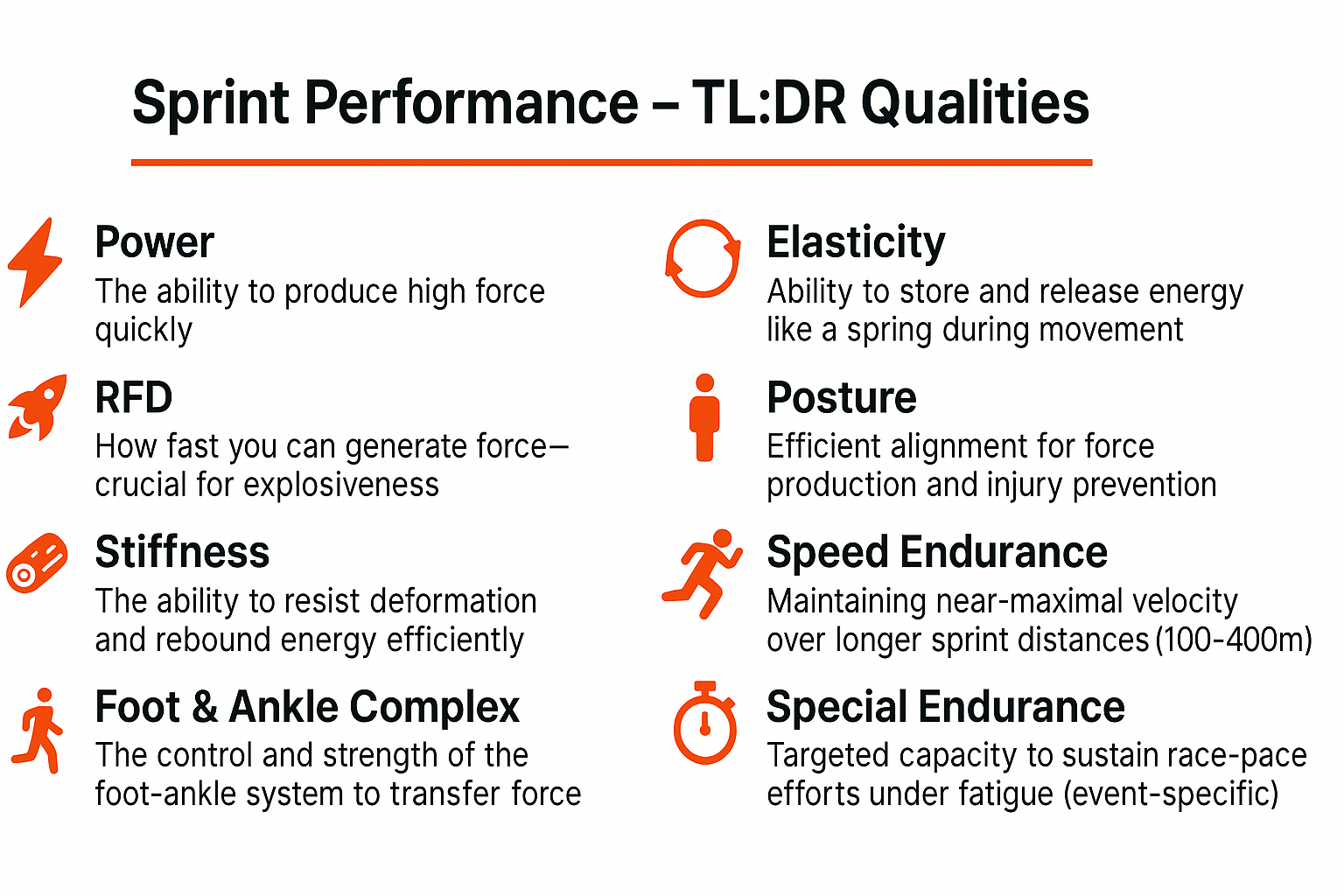
Sprint qualities are the specific physical and technical attributes that determine a sprinter’s ability to accelerate rapidly, achieve maximum velocity, and maintain speed efficiently. These trainable characteristics include power (force production in minimal time), rate of force development (RFD), stiffness (muscle-tendon resistance to deformation during ground contact), foot and ankle complex strength, elasticity (ability to store and release energy), proper posture and pelvic control, coordination and rhythm, and speed endurance. Elite sprinters develop these qualities through targeted training methods to optimize performance across all phases of sprinting.

Thinking in “qualities” beats chasing random drills because it provides a comprehensive framework for developing speed that targets the underlying athletic attributes needed for sprinting success. Here’s why this approach is superior:
Quality-based training addresses the root causes of speed rather than just copying what fast sprinters do. When you understand that speed requires specific physical qualities (power, stiffness, elasticity, etc.), you can systematically develop these attributes rather than randomly implementing drills that may not address your specific weaknesses.
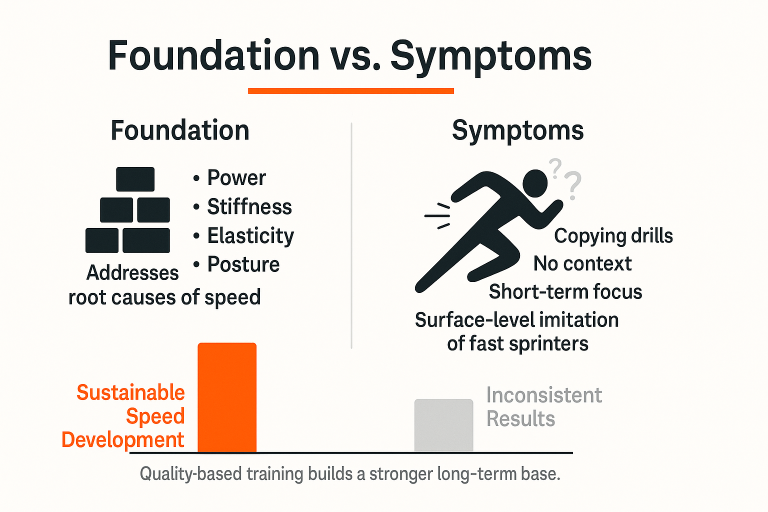
Sprint drills serve two primary purposes:
Many common drills offer limited transfer to actual sprinting because they lack horizontal ground speed and proper push mechanics. Elite sprinters who perform these drills already possess the underlying qualities that make the drills effective.
Transfer of Training (of Sprint Drills)
“The drills themselves don’t make you faster. Integrating the drills into your mechanics is what makes them faster.” Many athletes mistakenly believe that repetition of drills alone guarantees improvement, when what matters is how those drills translate to actual sprint mechanics.
Systematic Development
A qualities-based approach allows for systematic progression:
Different athletes need to develop different qualities based on their unique strengths and weaknesses. By thinking in qualities, coaches can identify an athlete’s “weakest link” and address it specifically, rather than assuming all athletes need the same drills.
Speed is built on the integration of multiple qualities working together. For example, “stiffness + elasticity = bounce”, which is essential for elite speed. Understanding how these qualities interact helps create more effective training programs.
By focusing on developing fundamental qualities like power, stiffness, elasticity, and coordination rather than copying specific drills used by elite athletes, you create a more robust foundation for speed development that addresses your unique needs as an athlete.
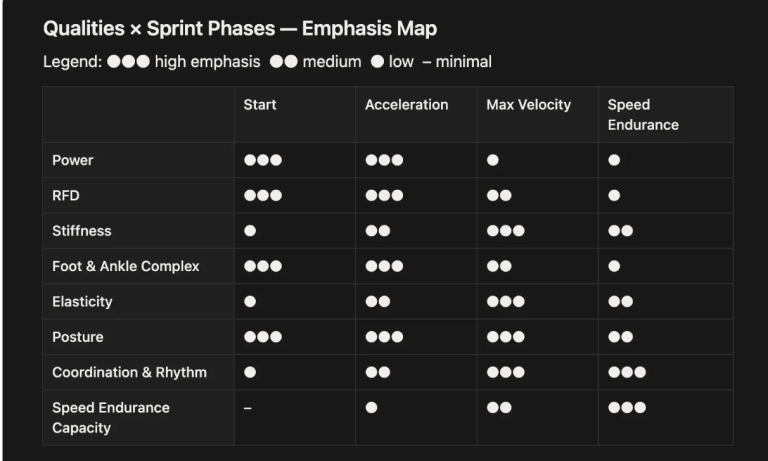
Notes
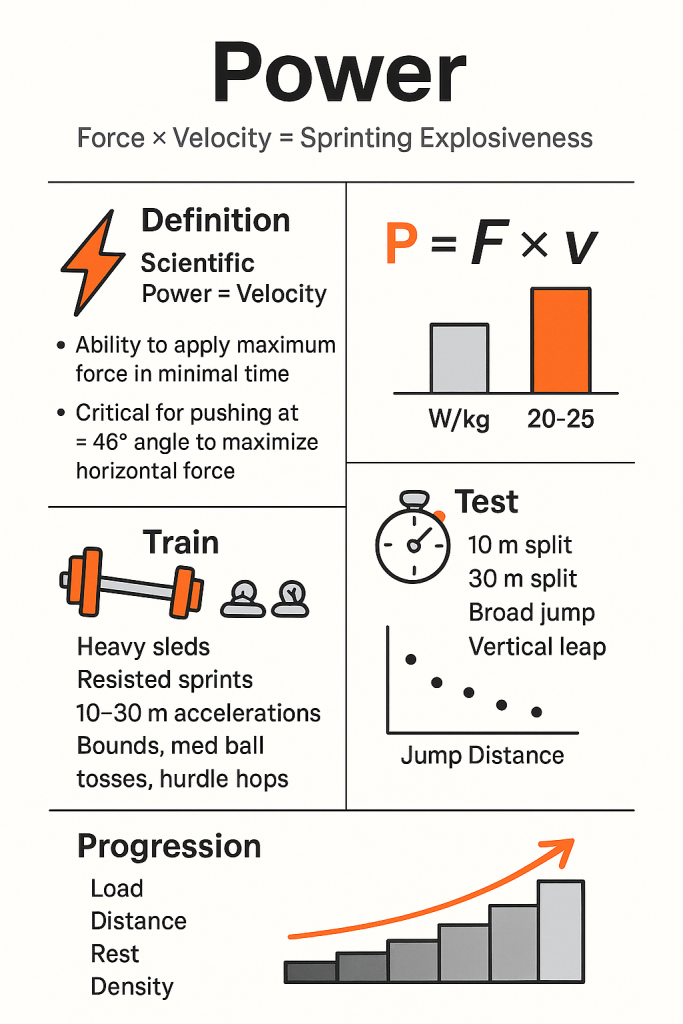
Scientific Definition:
Power in athletics is scientifically defined as the product of force and velocity (P = F × v), or the ability to exert maximum force in the shortest time possible. Elite sprinters can generate approximately 20-25 watts per kilogram of body weight during peak velocity.
Sports Performance/Sprint-Related Definition:
In the context of sprinting, power is:
Power can be increased by either increasing the force or by decreasing the time over which that same amount of force is applied. This is also known as Rate of Force Development (RFD).
For sprinting specifically, there’s a minimum threshold of power an athlete needs to generate to effectively push out of a start position at the right angles (approximately 45°) and apply force into the ground in a horizontal orientation.
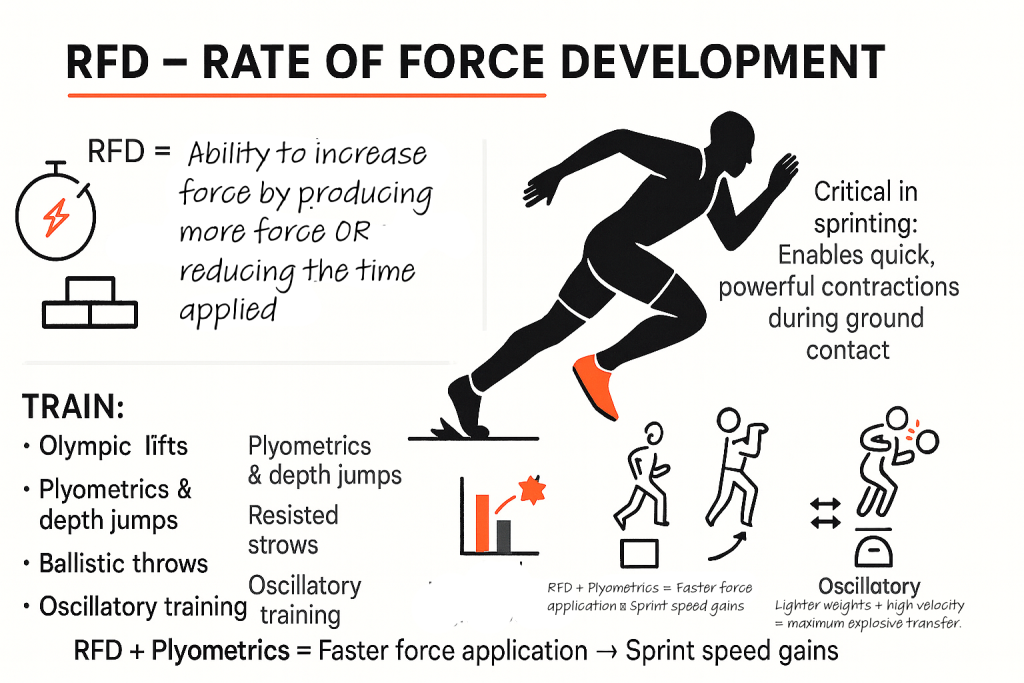
Definition: RFD stands for Rate of Force Development. It’s described as the ability to increase force production by either increasing the total force or by decreasing the time over which that force is applied.
In sprinting, RFD is a critical component of power production and directly impacts an athlete’s ability to generate quick, powerful muscle contractions during ground contact phases.
Ballistic exercises are explosive movements where the athlete applies maximum force to accelerate an object (like a medicine ball or barbell) and then releases it or allows it to become airborne. These exercises are characterized by:
Examples of ballistic exercises include:
Ballistic training is most effective when programmed strategically within a training plan, particularly during power and speed acquisition phases. It works well when combined with plyometric training to enhance explosive power development for sprinters.
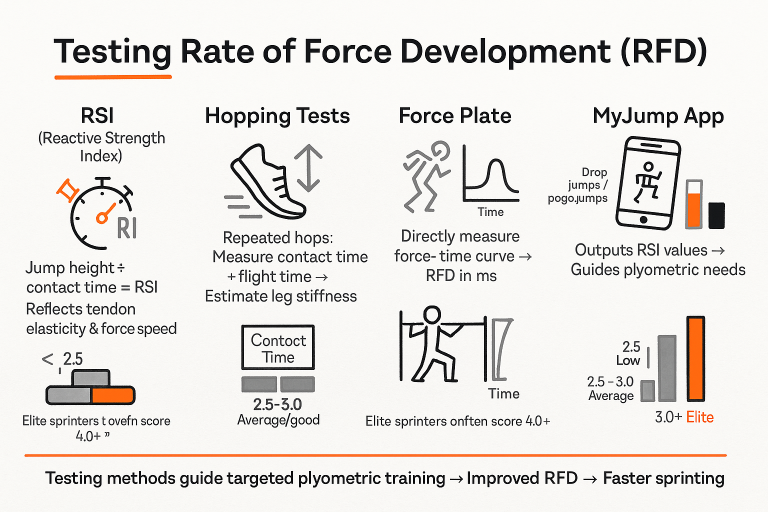
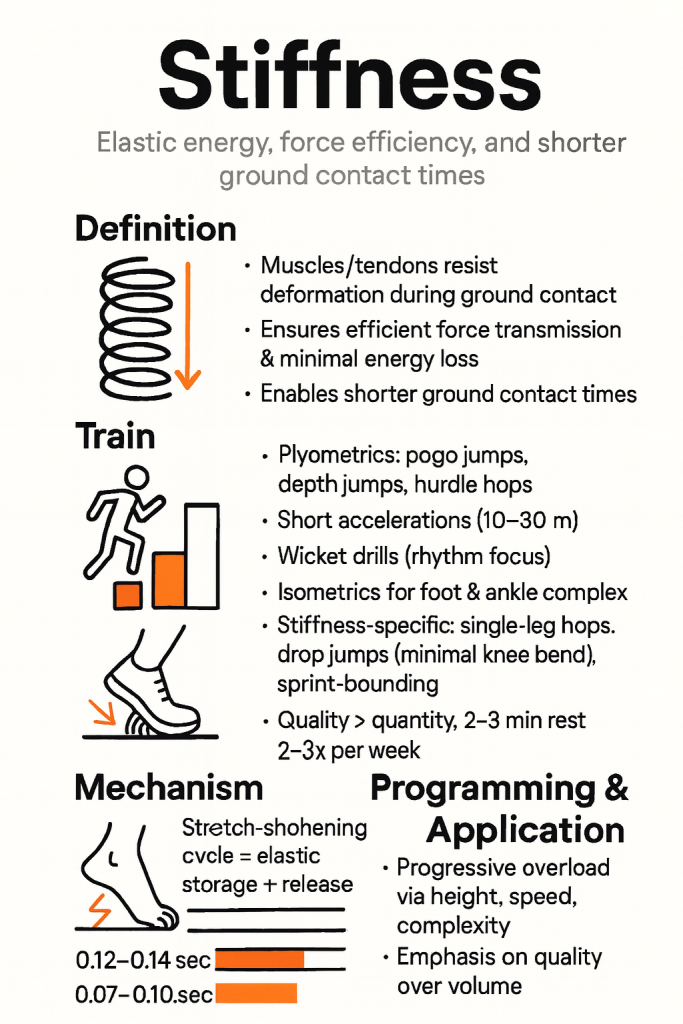
Definition: Stiffness in sprinting refers to the ability of muscles, tendons, and connective tissues to resist deformation during ground contact. It ensures efficient force transmission, minimizes energy loss through excessive joint flexion, and enables shorter ground contact times. Higher leg and ankle stiffness allows sprinters to quickly rebound off the ground, storing and releasing elastic energy more effectively during the stretch-shortening cycle. Elite sprinters typically exhibit greater tendon stiffness, particularly in the Achilles tendon and foot-ankle complex, which contributes to their ability to maintain proper mechanics at high velocities.
Train: Plyometric exercises like pogo jumps, depth jumps, and hurdle hops that emphasize minimal ground contact time. Short sprint accelerations (10-30m), wicket drills with precise rhythm, and isometric exercises targeting the foot and ankle complex. Stiffness-specific exercises include single-leg hops, drop jumps with minimal knee bend, and sprint-bounding with emphasis on quick ground contacts.
Progressive overload by increasing height, speed, or complexity rather than volume. Aim for quality over quantity with full recovery between sets (2-3 minutes) to maintain optimal neuromuscular response. Ideally, program stiffness training 2-3 times per week with 48 hours between sessions for neural recovery.

Definition: The foot and ankle complex refers to the intricate system comprising 26 bones, 33 joints, and over 100 muscles, tendons, and ligaments that function as a lever and spring during sprinting. This biomechanical unit is responsible for approximately 35-45% of total propulsive force generation in sprinting, making it a critical component of athletic performance. A stronger foot and ankle complex allows sprinters to efficiently transfer power from the legs into ground force, particularly through the calf muscles (gastrocnemius, soleus), smaller stabilizers, and intrinsic foot muscles that act like a “foot core” to maintain arch integrity during high-force ground contacts.:
The foot and ankle complex is a critical performance determinant for sprinters and explosive athletes because it serves as the primary interface between the athlete and the ground. Here’s why it’s so important for preventing energy leaks and improving performance:
Elite sprinters typically develop extraordinary foot and ankle strength, stiffness, and coordination through specialized training that targets this critical system. Training methods like hill sprints, banded starts, and push-up starts specifically develop this quality.
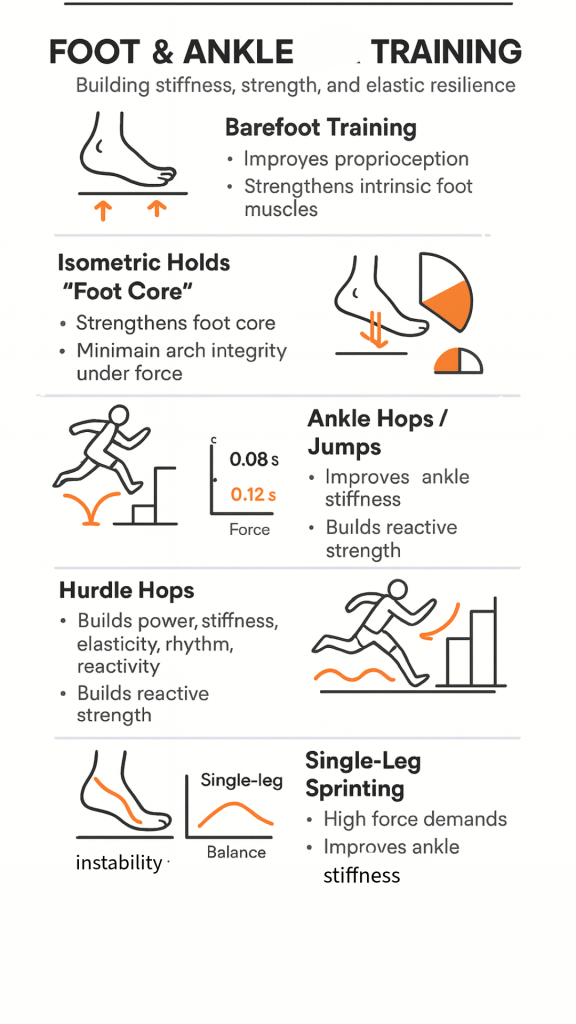
Tests:
Elasticity in sprinting refers to the ability of muscles, tendons, and connective tissues to efficiently store and release energy during the stretch-shortening cycle. This biomechanical property allows athletes to:

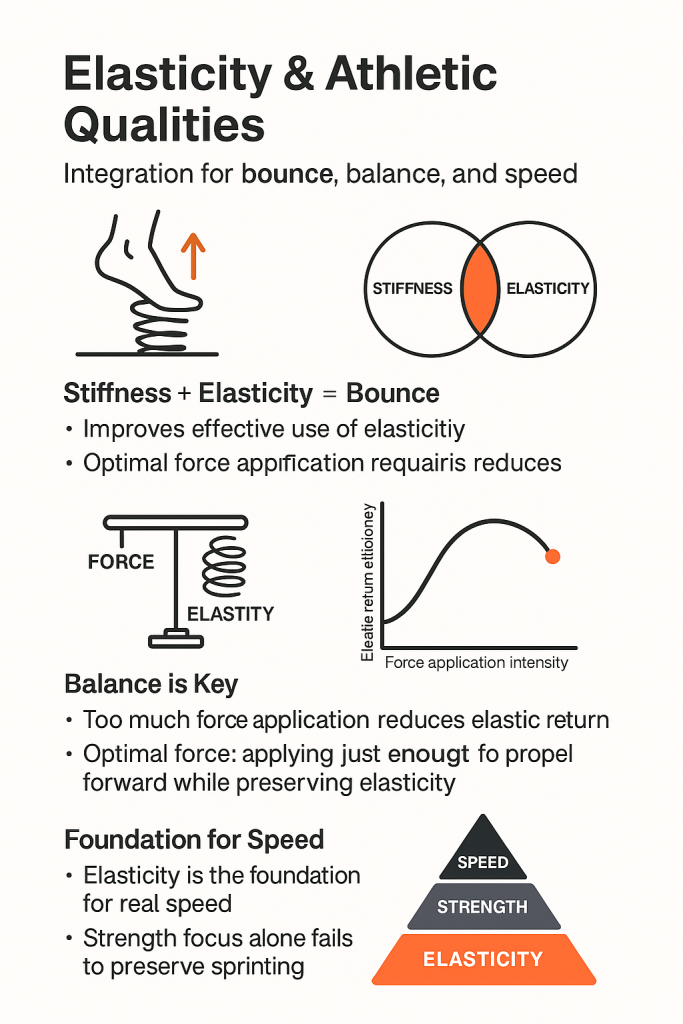
Elasticity doesn’t work in isolation – it functions as part of an integrated system:
Research shows that these methods lead to significant improvements in elastic qualities, which directly transfer to faster sprinting through improved energy storage and release during the stretch-shortening cycle.
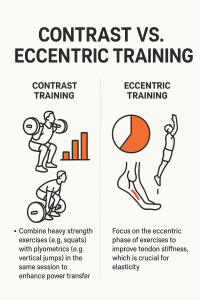
Research shows that these methods lead to significant improvements in elastic qualities, which directly transfer to faster sprinting through improved energy storage and release during the stretch-shortening cycle.
theSprint.Club Tweet
Testing elasticity is essential for tracking an athlete’s development and designing effective sprint training programs. Here are proven methods to assess elasticity qualities for sprinting:
For optimal results, implement regular testing (every 4-6 weeks) to track improvements in elastic qualities as training progresses. Document both performance metrics and subjective feedback on “bounce” quality to create a comprehensive elasticity profile that evolves with training.

Definition:
In sprinting, posture refers to the body’s alignment and position during different phases of the sprint. It has significant impacts on force application and overall performance. Here’s how posture functions in different sprinting phases…

During acceleration, proper posture involves:

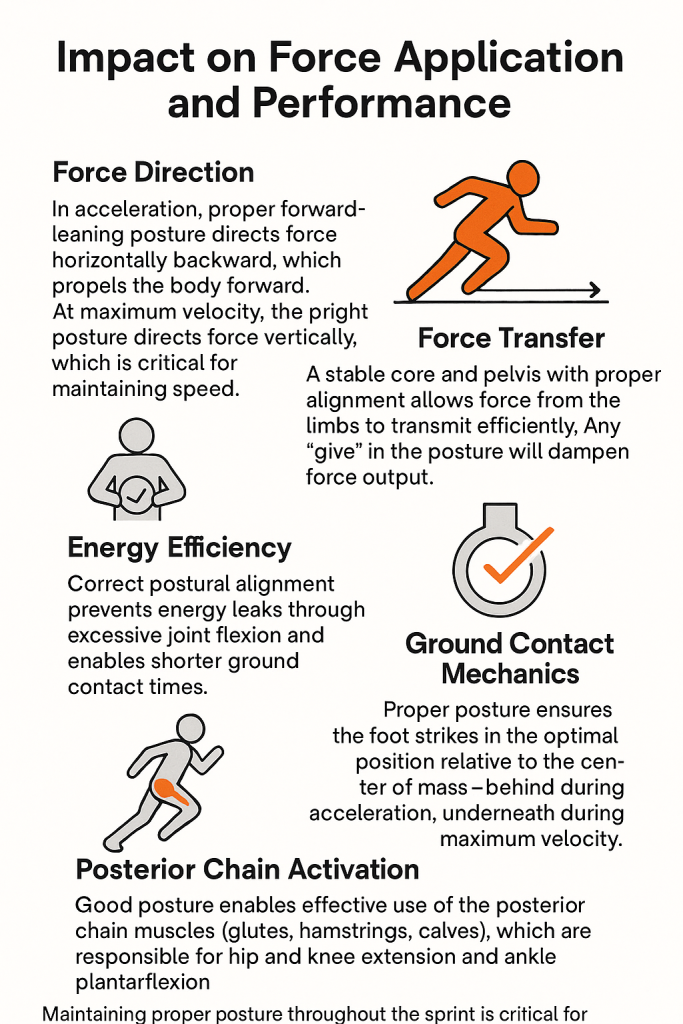
Posture directly affects force application in several ways:
Maintaining proper posture throughout the sprint is critical for maximizing sprint performance. Elite sprinters demonstrate exceptional postural control that enables them to apply force efficiently at both acceleration and maximum velocity phases.
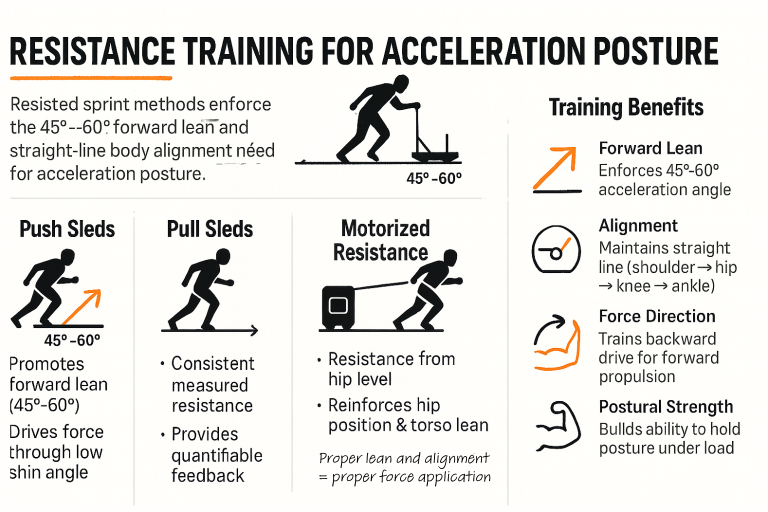
These tools are effective because they:
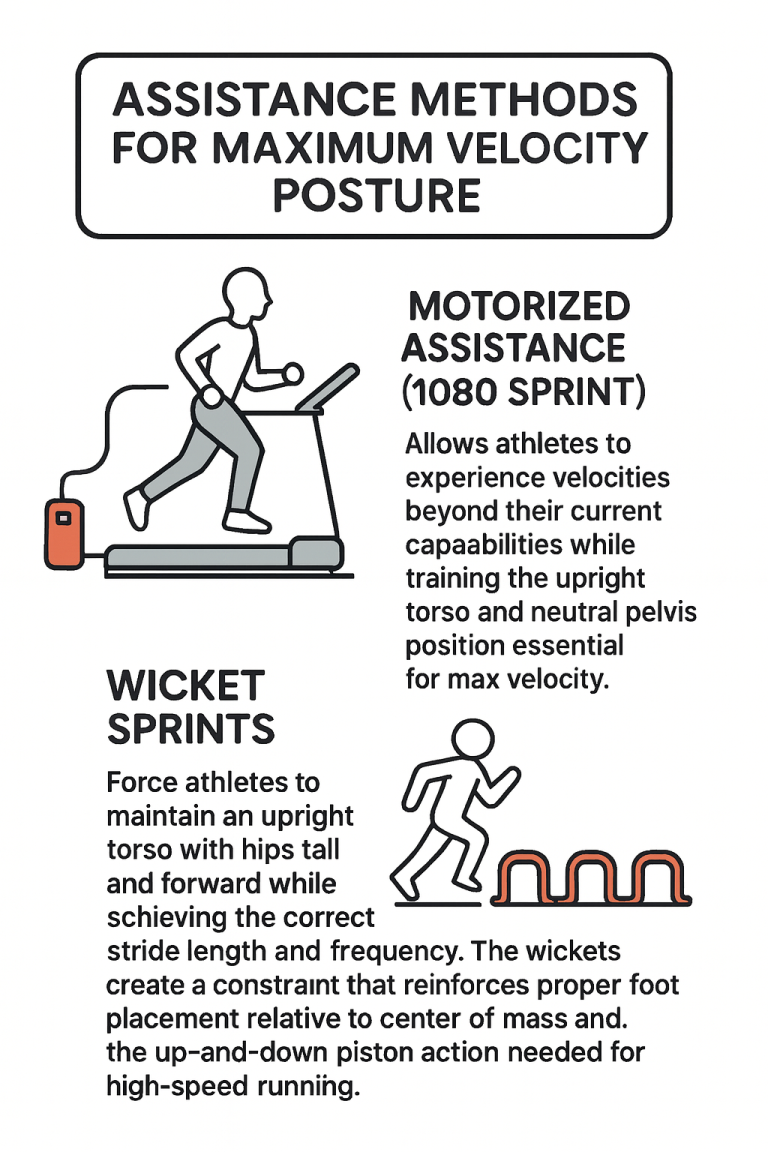
These methods are valuable because they:
Both resistance and assistance methods create specific constraints that make proper posture not just a cue but a necessity for successful execution of the drill, helping athletes internalize the correct positions needed for optimal sprint performance.
Using video analysis is an excellent way to improve sprint posture. Here’s how to implement it effectively:
Acceleration Phase:
Maximum Velocity Phase:
Research shows that improving posture can lead to enhanced sprint performance and reduced injury risk. A study by Mendiguchia et al. demonstrated that a multi-factorial approach including technical sprint training led to improvements in toe-off distance, contact time, anterior pelvic tilt, and touchdown distance—all key determinants of sprint success.
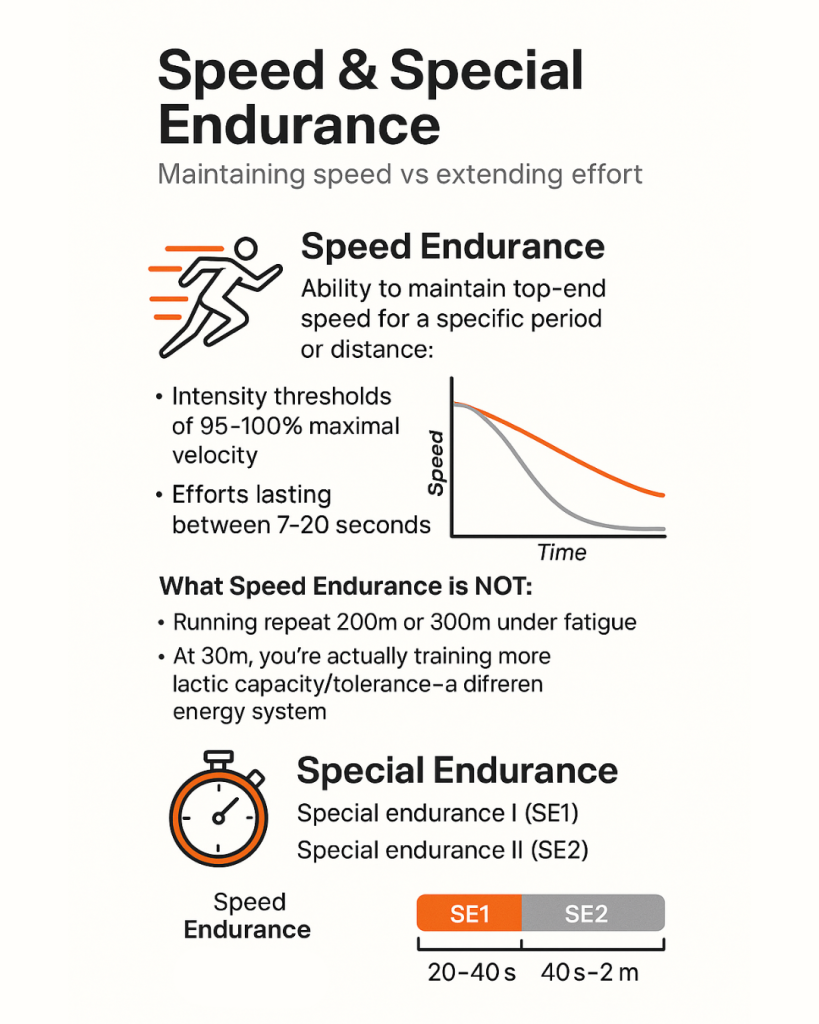
Definition: Speed endurance refers to an athlete’s ability to maintain top-end speed for a specific period or distance. It specifically involves:
What Speed Endurance is NOT:
Speed endurance is not running repeat 200m or 300m under fatigue where athletes are running well below 90% maximum velocity.
If you’re not running at high speeds… you’re not enduring speed.
At 300m, you’re actually training more lactic capacity/tolerance – a different energy system altogether.
Definition: Special endurance is further divided into:
From an energy system perspective:
The three energy systems (alactic, lactic, aerobic) don’t operate in isolation but influence each other in all sporting activities. However, the dominant system changes based on the effort duration.

Speed Endurance Training:
Special Endurance Training:

Training Methods:
Key Training Principles:
Common Mistakes to Avoid:
Remember that in sprint training, you must prioritize maximal velocity development first, as speed endurance is about maintaining that velocity. As the saying goes: “What are you trying to endure if you don’t have speed?”

Discover how modern biomechanics is reshaping sprint training, replacing outdated “base building” with max velocity and acceleration-first methods.
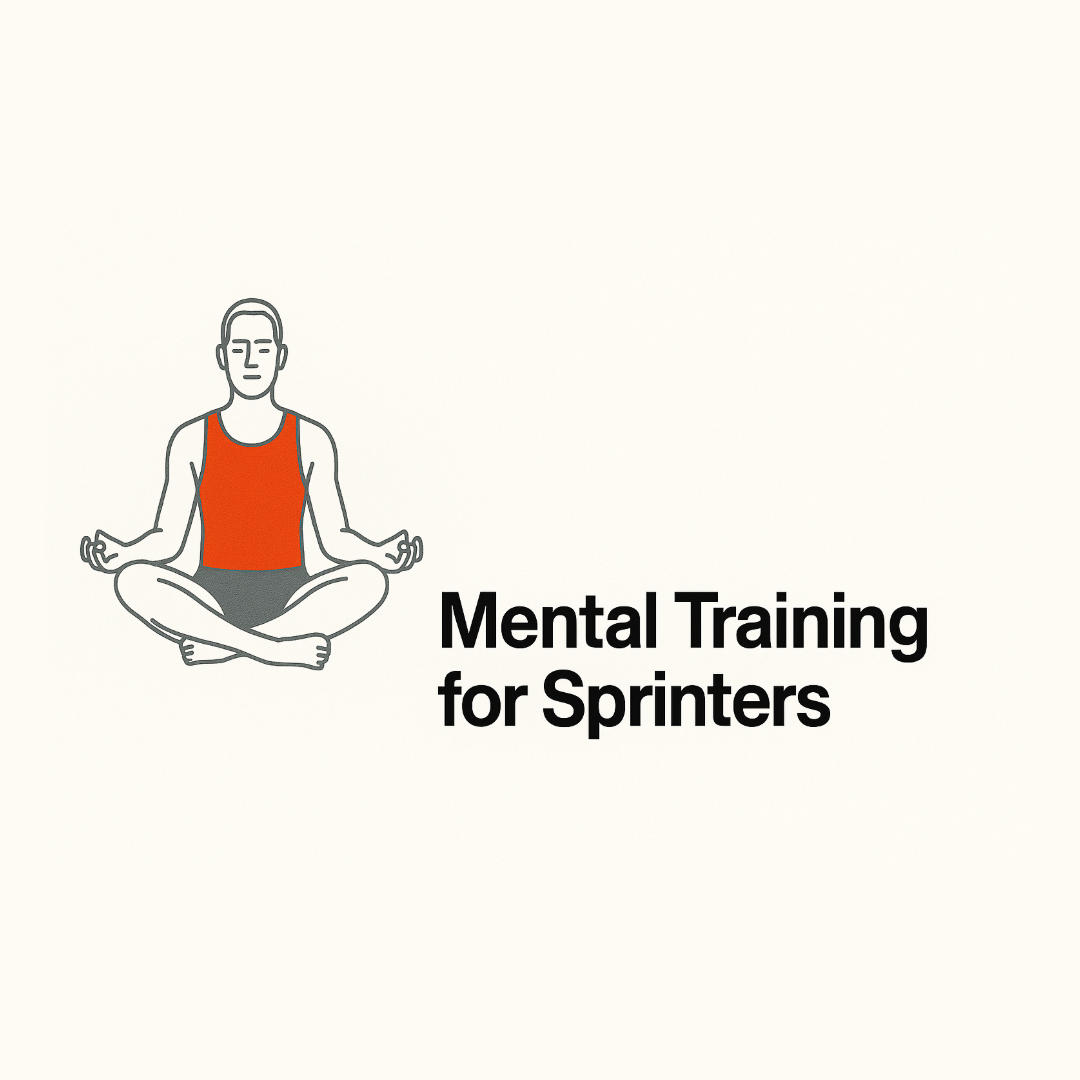
Unlock sprinting speed with proven mental training. Learn visualization, mindfulness, and sports psychology techniques to boost explosive performance.

Should sprinters focus on work capacity or speed quality? Discover the truth about GPP vs SPP and the real goal of sprint training.

